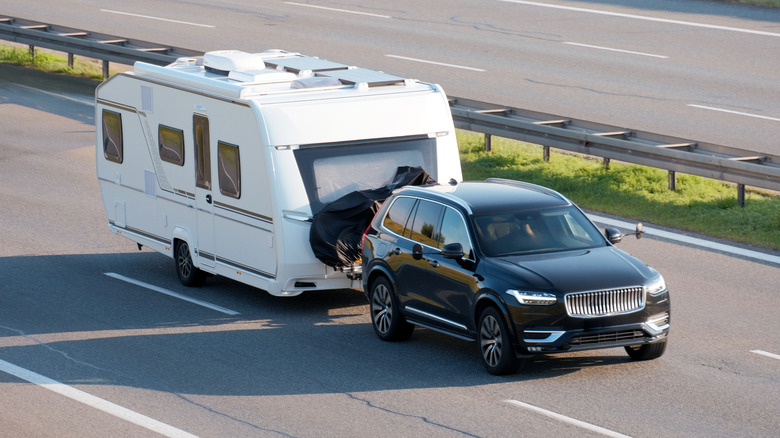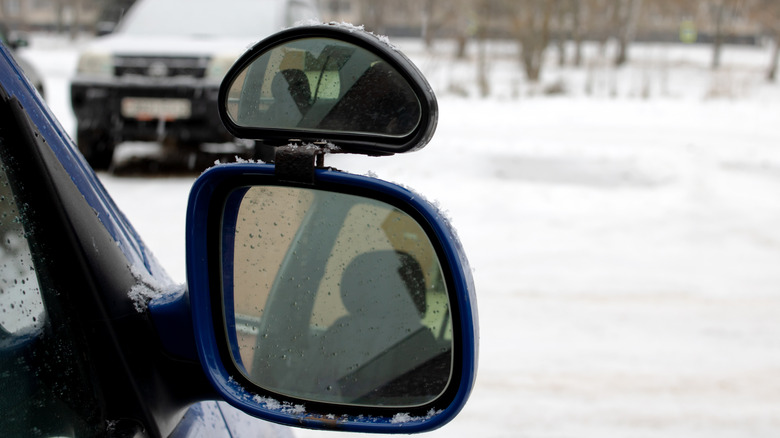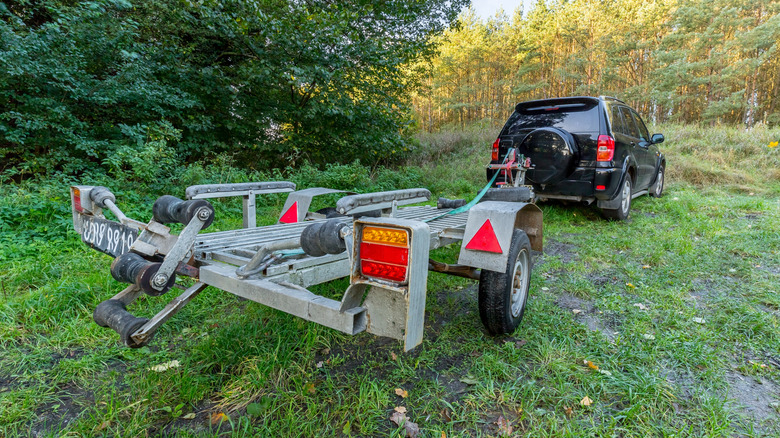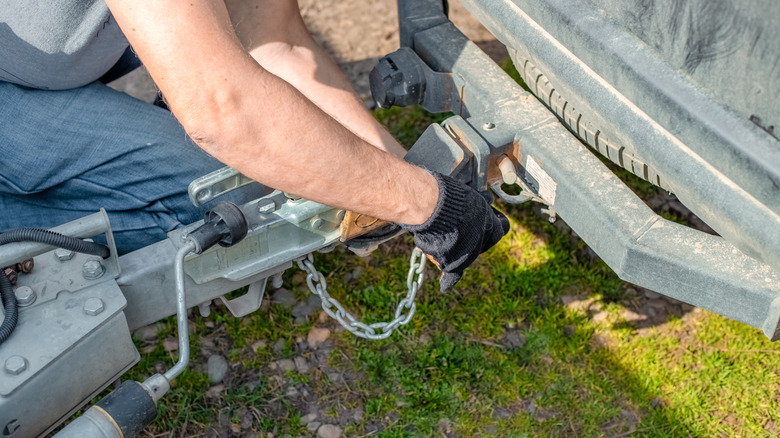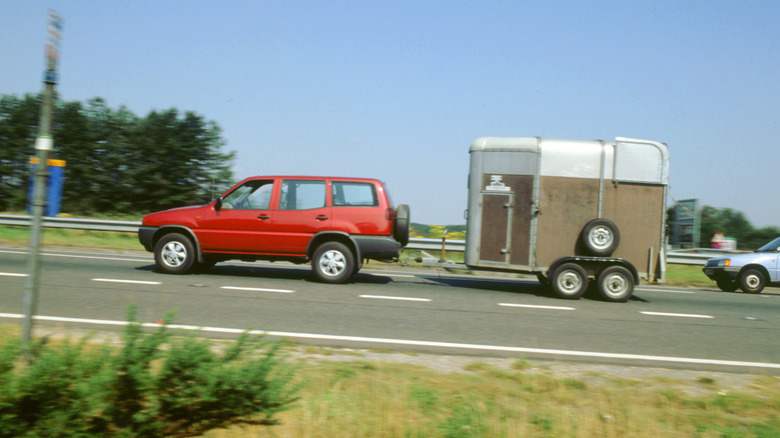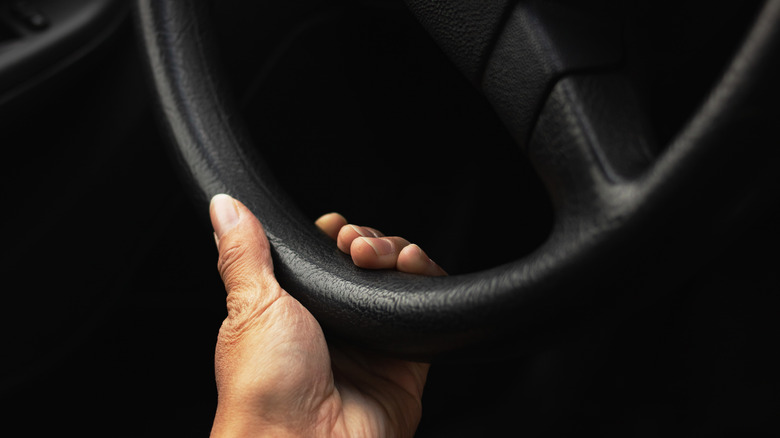11 Tips To Safely Tow A Trailer Or Camper
Towing a camper, boat, or trailer loaded with equipment or supplies is a common task. Drivers across the country own vehicles with tow hitches installed alongside the rear bumper infrastructure, and plenty of SUVs and trucks are purchased specifically to accommodate these needs. You might be loading a motorcycle onto your trailer or pulling a full-sized camper attachment for a weekend of fun, but either way, the task of hauling heavy gear is a uniquely challenging one. This is true regardless of whether you're the proud owner of one of the best travel trailer brands, hitching up a boat trailer, pulling two tow boxes, or hauling junk to the scrapyard. Even lightweight trailers that make towing a bit easier require a few important techniques and safety measures to ensure a successful haul.
Keeping these crucial safety tips and tricks in mind can be the difference maker when it comes to an uneventful journey versus one that's fraught with difficulties and problems. From properly hooking up your trailer to navigating turns and performing other maneuvers on the road, these are some of the most important factors to consider when pulling additional equipment with your vehicle.
Get your connection lined up first and hook the trailer securely
The first thing anyone attempting to tow a trailer or camper will need to do is ensure a secure connection. If your trailer isn't properly attached to the hitch on your vehicle, you can't expect to pull anything safely. Once you've settled on a hitch that makes sense for your needs, lining up the hook with the connection point on your trailer is crucial.
Many contemporary vehicles today feature cameras and other technology that help make backing up a breeze. With this type of aid, it's easy to align your car or truck directly in front of the camper or trailer's connection point. Even with this sort of augmentation involved in your reversing, having a friend help guide you back toward the trailer in a straight line can be extremely helpful. With someone helping you outside the vehicle, backing straight toward your trailer and stopping in the exact location to support a straightforward connection is easy to achieve.
Dropping the trailer's connection point down onto the ball hook requires rotating the lever on your trailer's forward infrastructure. This drops down the front end, allowing you to secure the joint. Once you've solidified this connection, raise any components that may be sitting on the ground, like a jack foot or wheel. These are used in support of the hookup, but must be returned to their upright position when driving.
Adjust your mirrors accordingly once the trailer is attached
After you've successfully connected the towable item to your vehicle, you should get behind the wheel and test out your mirrors. Adding additional length to the back of your car will impede your vision. Even if the trailer is slight in its frame, the new dimensions of the total vehicle you are operating are substantially different than what you are used to driving. The added size in the back requires you to adjust your mirrors so that you can continue to see the road and other drivers around you effectively. The problem is particularly significant with connections like large campers that are often both taller and wider than your vehicle. This means that your rearview mirror may be rendered useless, and your side-viewing options will become impeded or totally blocked as well.
Making adjustments to improve your visibility is just one step in the right direction. Many people who tow large objects behind their SUV or truck also add mirror extensions into the mix. This is an extra attachment that goes beyond the existing mirror layout on each side of your vehicle. Adding extensions gives you a wider vantage point, expanding your field of vision and introducing added safety to your driving. This addition won't always be necessary, but with particularly wide loads it can be a real lifesaver.
Ensure that your trailer lights are connected and working properly
Another important step to take before you even consider hitting the road involves your lights. In most instances, the trailer you're towing behind the vehicle needs to feature the same back-end lights that are on your truck or SUV. Brake lights, turn signals, and illumination to cover the license plate are all typical inclusions on modern trailers. These models often feature a simple wiring connection between your vehicle and the trailer. Making this singular connection at the tow hitch area is all that's required to remain within the boundaries of the law in this regard.
However, if you are driving with an older towable camper or trailer, lighting elements may not be included in the framework of the vehicle accessory. In this case, you'll need to make the proper arrangements yourself. Adding third-party lighting to the object you're towing isn't typically very difficult, and plenty of options can be found across the marketplace. Either way, making sure that your lights are operating correctly and providing coverage across all of the required areas before you get on the road is one of the final checks standing between loading up a trailer and towing it to its destination.
Apply the 80/20 rule when towing anything behind your vehicle
It is critically important to determine your individual vehicle's towing capacity. If your truck can tow 10,000 pounds, for instance, you have plenty of leeway in loading up equipment on the back of the trailer or vacation essentials within a camper. However, a towing rating like that doesn't necessarily mean you should actually tow 10,000 pounds of material. In fact, an important rule of thumb to keep in mind is the 80/20 rule. Keeping with this example, your effective towing capacity would actually be 8,000 pounds, because safe drivers seek to keep their own personal threshold at 80% of the vehicle's rated towing capabilities.
The reason for this lower cap lies in the variety of real-world conditions you may encounter while towing. Manufacturer towing capacity ratings take into consideration only optimal conditions. This means towing on a steep incline, in rainy or snowy conditions, or even with tires that have seen better days, can make the experience significantly more difficult and even perilous. Moreover, just because you can tow up to a certain amount doesn't mean that your individual skill as a driver will actually allow for the safe towing of that full load hurtling down the highway directly behind you and your vehicle. Keeping your own personal capacity at 80% of the total weight rating offers some wiggle room for potential additions later on, and it provides an important safety measure to help maintain control of the vehicle and the object it's towing at all times.
Check your trailer's tire pressure and overall health
It's common for drivers to inspect the health of their vehicle's tires. Checking in on tire pressure and the wear pattern on the treads helps you keep your car performing at its best. Tires that are beginning to go bald maintain less grip on the road, and eventually, they can become a significant hazard to your control behind the steering wheel. When loading a trailer and preparing to tow equipment from one place to another, walking around the vehicle to inspect the tires is a natural first step. But some drivers fail to take the same consideration for the wheels of the trailer itself.
Because these additional elements don't spend as much time on the road as a typical car or truck, you might fall into the trap of thinking that the tires don't require inspection as frequently. You might even think there's no real difference between car and trailer tires. But the reality is that a flat tire can happen for numerous reasons, and damage to the side walls or tread pattern of your trailer's tires can be extremely hazardous. Making sure that the tires on the object you'll be towing are in good working order before hitching it up is yet another safety precaution that you can't afford to overlook.
Engage the safety chains for a security blanket of last resort
During the hitching process, simply connecting the housing to the ball joint isn't enough to get the job done. After you've lowered the trailer onto the tow hitch, engage the safety chains to add a layer of security that will protect you, your belongings, and others on the roadway in the event of a sudden emergency. If you have engaged the tow hitch correctly, there's little reason to believe that it might fail while you're driving. This outcome is unlikely, but it still can happen. The safety chains are there to prevent a mishap like this from spiraling into a catastrophe.
Safety chains should be engaged in an X-pattern across the towing connection. It's important to note that these chains alone can catch and pull a trailer temporarily if it breaks away from the hitch. This is their purpose. However, they should never be used as a primary means of towing a camper or trailer. Always use them as a safety precaution, but replace your equipment if you find that your trailer connection has failed and relies primarily on these chains during a trip.
Evenly distribute the weight you're hauling
Regardless of the object you are towing behind your vehicle, an even weight distribution is a critically important step to ensuring a safe journey. Whether it's across town or the country, distributing the weight of your load evenly across the midline of the towable feature will help you maintain control while on the road. This is equally true for loading your essential camper accessories or hauling equipment. If you stack too much weight on either side, turning corners can become a dangerous maneuver. Likewise, driving at speed on highways and other open roads can introduce sway that sees you lose control at the worst possible time.
Placing weight in roughly a 50-50 distribution across the left and right sides of your trailer helps protect against these dangerous outcomes. It's also important to place around 60% of the total load in the front half of the object you're towing, with roughly 40% in the back half. This helps keep it grounded and angled appropriately as you drive along. Finally, the tongue weight, or the weight that is distributed directly on top of the hitch connection, should be roughly 10 to 15% of the total you plan to pull. Hitting these numbers allows you to confidently cruise around town or hit the on-ramp to traverse the interstate highway system.
Keep your speed low and assume you need twice the stopping distance
Speaking of driving on highways and other roads with higher speed limits, it's important to remember that when towing heavy objects you will need to pay careful attention to your speed and other elements of the driving experience. When you switch lanes, speed up, slow down, or perform other maneuvers, you'll need to account for extra time in the process.
Building up speed requires additional muscle when the vehicle is towing an extra few thousand pounds, and the same can be said for braking. Mathematicians might be quick to note that you certainly have the ability to calculate stopping distances with all the information about speed and weight available to you. However, when driving along the highway, there's no time to pull out a calculator. Instead, a good rule of thumb is to assume that you need twice the usual stopping distance. Keeping this mental framework can be particularly useful when you need it most.
Stopping distances aren't the only thing to keep in mind when driving with a trailer connected to the back of your vehicle. Just because the speed limit on a highway might be 70 miles per hour doesn't mean you have to drive at that speed. If you are unfamiliar with the road or have been driving for a long time, slowing down is often a good way to keep yourself safe in roadway conditions that may be dangerous. Just as slower speeds are important when it starts to rain, while towing a trailer, you'll also want to drive below the speed limit. This helps maintain your control over the entire vehicle.
When making turns don't forget to account for the added length
Another maneuver that becomes increasingly difficult with added length and weight attached to the back of your vehicle is the simple turn. The typical car, even in large SUV or truck format, features fixed axles and a relatively standard length. Turning corners is such a commonplace task while driving that most drivers won't think twice about it. Taking a corner when pulling a trailer is an entirely different process, however. The trailer creates a pivot point behind your vehicle, and it may extend the length of your total road presence by a factor of two or more.
If you are new to the world of towing campers or trailers, practicing with cones in an open parking lot can help you gain confidence. In order to successfully execute a turn with the trailer, you'll want to drive a little farther in a straight line past the point where you would normally initiate the turn. This will bring the front end of the trailer up to the turning point rather than beginning the turn based on your car's dimensions. Once you've reached this spot, you'll want to start turning the wheel a little more aggressively than you would without a trailer attached to your vehicle. Because all the power is coming from your vehicle and not the rear wheels of the trailer, getting your car around the corner once you've guided it past the curb or island will help pull the trailer into the correct position as you straighten out in the new direction.
If you experience sway, don't speed up (or slam on the brakes, either)
Driving on the highway induces a tendency to zone out. This is something that people pulling trailers and campers should fight to avoid at all costs. With extra length and weight behind your vehicle, maintaining your focus is more important than ever. Therefore, if you feel yourself starting to fall into the pattern of highway hypnosis, pulling off the road and taking a break is often your best bet. One of the most common behaviors that you'll find when falling into these kinds of patterns is a tendency to speed up unintentionally.
When towing something behind your vehicle, increasing your speed can sometimes introduce a phenomenon known as sway. This is a gentle rocking that occurs in the trailer behind your car, and if you don't address it when it creeps into the picture, it can become unmanageable.
If the trailer begins to sway back and forth, you should slow down. Some drivers suggest speeding up as a way to defeat this problem, but unless you are an extremely experienced towing driver, there's a greater chance of causing irreparable harm by following this advice. Don't slam on the brakes, as this will cause your vehicle to lose control. Take your foot off the accelerator and let the car and the trailer slow down gradually. Once the sway is under control, gently press the brake pedal in order to slow it down even further. From here, you can reassess your speed with the entire vehicle under control and resume your journey.
When reversing, place your hand at the bottom of the steering wheel
Finally, drivers often struggle with reversing, even without a trailer sitting behind their vehicle. Many people have internalized the reality that when moving in reverse while towing additional equipment, your car will turn in the opposite direction to the way you swing the wheel. Having to think about this feature can introduce additional mental gymnastics that make reversing even harder. One easy trick to combat this reversing problem is a simple change of hand position. Because the steering wheel is fixed in place, moving your hand from the top of the wheel to the bottom allows you to shift the way you interact with it. Instead of turning the car in the opposite direction to the way you move the wheel, maintaining a pivot point at the bottom of the steering wheel allows you to turn the wheel in the same direction that you want to move.
This easy change can revolutionize the way you reverse both with and without a trailer behind you. It's particularly valuable for those pulling a trailer, though, because it simplifies the process that has already been made far more difficult with the introduction of this added feature. Testing this out for yourself in an empty parking lot or on the street in your neighborhood will give you a good sense of the trailer's mobility and help you gain additional confidence behind the wheel.
